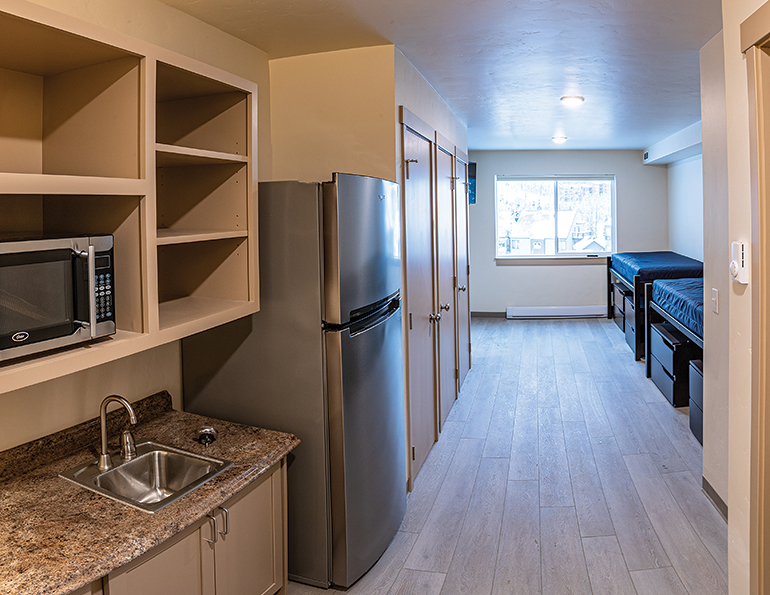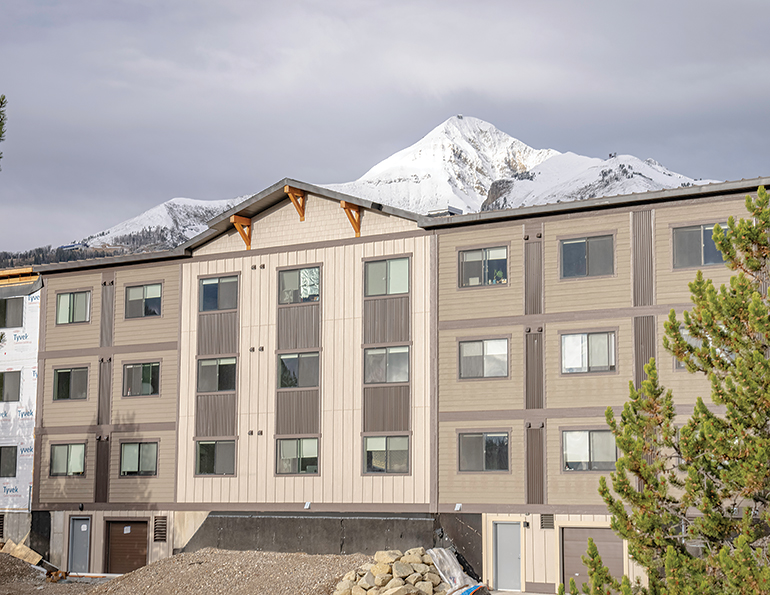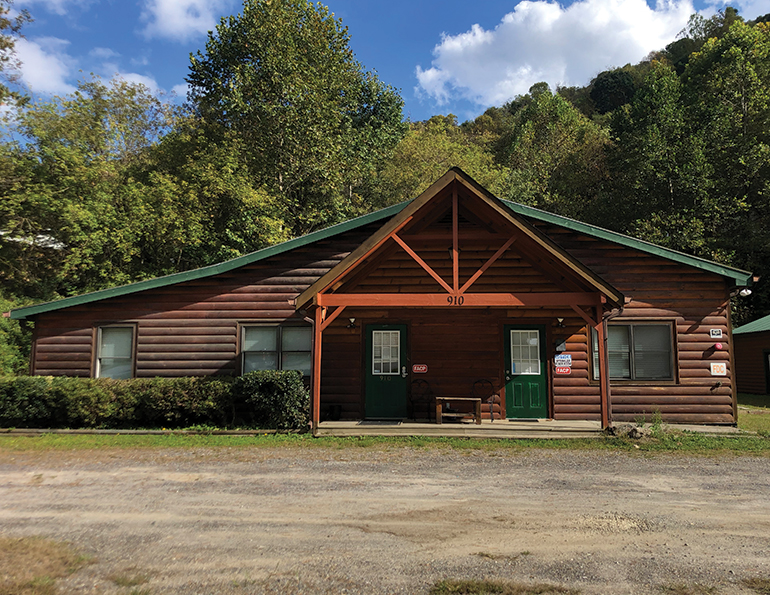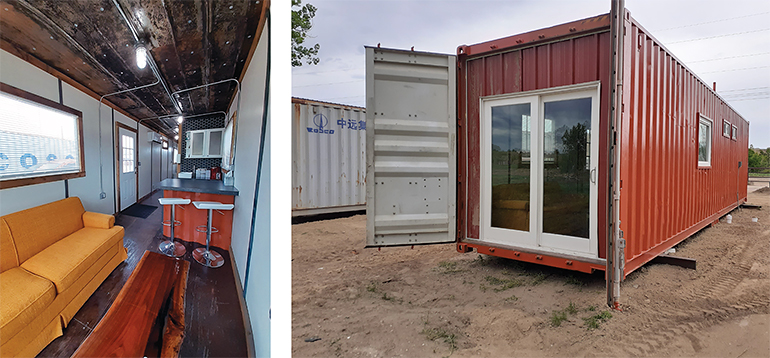Part 1 of this series, which outlines the industry’s housing crisis, appeared in SAM September 2021.
Employee housing has been an expense item in the Big Sky Resort budget for nearly a half century, dating back to Boyne Resorts’ purchase of the Montana ski area in 1976. The commitment to housing has grown substantially under longtime CEO Taylor Middleton, a transplanted Alabaman who moved there in 1980 when he first started at Big Sky as a hotel desk clerk. As a beneficiary of employee housing that helped change his life’s course, Middleton took a personal interest in the resort’s housing commitment, including building five projects in just the past six years. A sixth project, housing for mid-level staff, is in the works for 2022.
“What hope is there to attract great employees if you don’t have quality housing?” Middleton asks. “We have an obligation to take care of our employees.”
Big Sky now houses some 700 primarily seasonal employees, more than a third of its peak workforce, and has plans to eventually add another 500 beds. The existing housing offers a host of conveniences: locations either within walking distance to work or on a close-in bus route; on-site laundry; and a resident manager. There is typically no first/last month’s rent or damage deposit requirement, and rent is charged only for actual nights stayed. Rental prices include utilities and Wi-Fi, are tied to a standard 30 percent of income, and equal roughly half of what the workers would pay in the free market.

 Big Sky houses about a third of its seasonal employees in workforce housing, much of which is within close proximity to the resort, as seen here.
Big Sky houses about a third of its seasonal employees in workforce housing, much of which is within close proximity to the resort, as seen here.
The resort has built its inventory and property management policies not by government decree (this is Montana, after all), but because it’s good business. And that has inspired a public program: the fledgling local housing authority just opened the community’s very first deed-restricted housing, a 52-unit complex. All this makes Big Sky Resort a poster child for how the private sector can drive solutions.
EMERGENCY MEASURES
And resorts need solutions. As summer was turning to fall, dozens of towns and ski resorts announced a flurry of stop-gap measures to slightly ease the pandemic-spurred, worse-than-ever housing crisis for the 2021-22 season, as more service interruptions due to labor shortages loomed on the horizon. Even with the delta variant surging and wildfires raging, housing was the talk of the town in ski country.
Taos Ski Valley, N.M., raised its minimum wage to $15 an hour—slightly more than the $14.94 living wage for Taos County—and plans to find beds for 40 more employees on top of the 100 it already provides. Mount Bohemia in Michigan’s Upper Peninsula went to $20 an hour. For the longer term, the Town of Vail placed a half-cent sales tax increase on the November ballot, which would raise $4.3 million annually for housing.
Short-term rental conundrum. Ski towns across the country have set out to tackle one cause of the shortage: an increase in the use of short term rentals (STR) by second-home owners, some of whom used to rent their properties to locals. From Winter Park to Telluride to Tahoe, various programs incentivized second-home owners to instead rent their properties to workers, with bonuses as high as $10,000 a year for a year’s lease to three employees.
In Breckenridge, the town council approved an ordinance to cap its STR licenses at 2,200, essentially buying time to further research the issue and produce a cogent plan. The vote came despite hundreds of angry second-home owners speaking out in opposition, according to the Summit Daily.
“We have too many people visiting, which would be well and good if we had the staff to service those people,” said council member Jeff Bergeron, who said the imbalance has “cheapened” the Breckenridge product. It’s yet another signal that the political climate is changing in the high country, and that there will be more steps in the future to reverse engineer the status quo and provide more workforce housing.
There is a lot of catching up to do, as housing needs assessments conducted across ski country show future demand ranging up to thousands of units in the coming years for a typical major ski community. Even before the pandemic, Summit County, Colo., predicted it would need 2,400 additional units in five years.
FROM THE TOP
For resorts, a critical first step is to have committed executives, like Big Sky CEO Middleton—and GM Chris Bates at North Carolina’s Cataloochee Ski Area, where the investment in employee housing ranks only behind lifts and snowmaking in capital outlay. Or in Colorado’s Roaring Fork Valley, where Aspen Skiing Company refused to allow the pandemic to halt its efforts, forging ahead on the $18.5 million Hub at Willits employee housing project in Basalt, which opened in spring 2021. The project added 150 employee beds, increasing SkiCo’s total to 820.
 Investing in employee housing units like this one is a top priority for Cataloochee GM Chris Bates.
Investing in employee housing units like this one is a top priority for Cataloochee GM Chris Bates.
There’s also a need for more frontline fighters like Laurey Carlson, the general manager of employee housing at Mammoth Mountain, Calif. Carlson’s held that post since 2004 (and been a resort employee for 40 years). She and her 10-person staff oversee 430 owned beds, plus 75 they lease in Bishop, 45 miles away.
With housing being such an uphill battle—one that hardly seems winnable—Carlson wonders how any newcomer today could accomplish what she and her husband managed: To start out as ski bums, embrace a career in the industry, pinch pennies to eventually buy a condo and then a house, raise kids, and put them through college.
In search of new ideas. Besides lobbying for capital and keeping a sharp eye on the local real estate and rental markets for any opportunities, Carlson goes as far as to ponder if local Forest Service campgrounds could be winterized for vans and RVs—far from ideal, but better than today’s reality, where the same camper-workers make do with a spot at the end of a barren road. She recalls being approached by Warren Miller two decades ago with a suggestion to use shipping containers to house employees, a proposal that drew chuckles nationwide. Today, a company in Florence, Colo., has stacked shipping containers to build an impressive prototype hotel—with the long-term goal of selling the product as affordable housing.
 Builders of a prototype shipping container hotel opening in Florence, Colo., plan to expand the idea to an affordable housing development.
Builders of a prototype shipping container hotel opening in Florence, Colo., plan to expand the idea to an affordable housing development.
“If we don’t try some of these wacky ideas,” says Carlson, “we’ll never know.” The resort business has flourished by sharing ideas and collaborating on everything from snowmaking to social media to instruction—and, most recently, on Covid preparedness. There’s a deep need to do the same on housing, to recognize the employees who are leading the fight, and to share ideas on everything from best practices to software.
THE BIG TWO
Vail Resorts, which has raised its minimum wage to $15, says it’s important that employees live in the communities where they work. The company has been increasing its staff housing inventory every year. It’s had mixed results in developing projects, though.
For example, the company won a hard-fought approval for the Booth Heights project in East Vail in 2017, which would have added 144 beds. But the development was derailed by neighborhood opposition and wildlife concerns.
Conversely, in Summit County, Keystone Resort enjoyed a collaborative success with the unique Village at Wintergreen, a mixed-rate workforce community with more than 400 beds. In this partnership, Keystone provided the land, Summit County and its housing authority served as financial contributors, and developer Gorman & Co., armed with tax incentives, handled construction. The village has three different types of units, allotted based on income level. This affords residents the opportunity to step up to a larger living space as their careers advance.
Alterra Mountain Company CEO Rusty Gregory started building employee housing when he was at Mammoth back in the 1990s, both as a resort executive and as a private developer. He calls the shortage a “major issue,” and says Alterra resorts from Sugarbush, Vt., to Crystal Mountain, Wash., have plans and funds to provide more housing. The Alterra business model is to let the individual resorts come up with the proposals, and to “fund the good idea.”
THE HOUSING TOOLBOX
Besides building units or buying and converting existing hotels/lodges, many resorts jump into the market to lease or buy individual units for use by employees, a practice that will only increase in the years ahead.
Towns are working to encourage the legalization and/or construction and increased use of “bandit units,” accessory dwellings attached to homes with their own separate entrances, bathrooms, and kitchens. Resorts would be wise to encourage employees who own homes to consider this option (and generously reward them for it). Less formal arrangements exist: Sugarbush offers homeowners who lease a bedroom to workers a season pass for a highly discounted $100.
Deed buyback programs have also become common in resort communities nationwide as an efficient way to transform free market second homes into workforce beds through cash incentives. The Town of Vail’s InDEED program is one of the most intriguing of these: It has no rent, sale, or appreciation limits, and requires only that the unit be lived in by a resident and eventually sold to a resident. Launched in 2018, the program has deed-restricted 162 units, providing beds for about 365 residents. The town spent $11 million to seed the program (an average of $68,000 per unit, considerably less than the true free market value). Vail’s goal: 1,000 units by the year 2027.
Finding the money. From federal grants to states for pandemic relief to President Biden’s “soft” $3.5 trillion (or less) infrastructure legislation slowly winding its way through the Capitol, there arguably has never been more government money potentially available for workforce housing. Can resort communities successfully lobby for their fair share, and manage to align funding with the timing of these projects, given that approval processes can often take years?
A promising candidate for federal Covid funds in Colorado is Steamboat, which is battling a surging housing crisis today but benefits from a wide valley with ample space. In August, the Yampa Valley Housing Authority closed on a 536-acre parcel west of town for $24 million, according to the Steamboat Pilot. Dubbed Steamboat 700, the property could be the site of 2,000-plus affordable housing units, essentially a city unto itself. Colorado Gov. Jared Polis, armed with roughly $650 million in federal pandemic funds, toured the property and declared it a perfect candidate for some of the cash, particularly because it is already owned by the town and could meet the grant requirements of being committed to a project by 2024 and spent by 2026.
Land of many uses. In 2018, the National Ski Areas Association shepherded a provision into the Farm Bill that allows resorts to lease and build housing on U.S. Forest Service land, even if the property is not contiguous to the resort. Dave Byrd, NSAA’s director of risk and regulatory affairs, had high hopes it might lead to a flurry of construction. But there has been none, partly because of the bill’s restrictions, including a 60-year lease limit (developers would prefer a minimum 100 years). Currently, there’s an early-stage proposal in Summit County for a 350-bedroom development. The opportunity expires in 2023, but NSAA plans to lobby to extend it.
SOMETHING HAS TO GIVE
In a perfect master-planned world, ski towns would have just the right number of “warm beds” for both visitors and residents, ensuring a strong economy and a world-class visitors’ experience while also preserving quality of life for locals.
Instead, towns are out of balance, with not enough affordable stock and too many “underutilized” units—and searching for ways to build or reverse engineer their way out of the problem. It’s likely that the most impacted communities will face ever more difficult policy decisions on increasing density for workforce housing, overcoming neighborhood opposition to proposed housing projects, and perhaps even building on revered open space.
As we reported in part 1 of this series, a recent survey by the Colorado Association of Ski Towns (CAST) and Northwest Colorado Council of Governments (NWCCOG) of mountain residents in the state’s six major ski counties—representing roughly a fifth of nationwide skier visits—showed they were overwhelmingly supportive of a variety of taxes and other legislation to ease the housing shortage. The report recommends real estate transfer taxes (RETTs) on second homes and enacting higher property taxes for second-home owners, and even instituting “vacancy taxes” for homes that are underutilized, i.e., not “warmed” by either visitors or workforce.
Planned ahead, still falling behind. U.S. resorts can find some hope and inspiration, but also a dose of reality, to the north. As skiing’s undisputed leader in employee housing, Whistler, B.C., houses more than 75 percent of its workforce (other ski towns range from roughly 30 to 60 percent).
Whistler was founded in the mid-1970s as the “most planned” community in Canada, under the purview of the British Columbia government and with the blessings of Prime Minister Pierre Trudeau. One of the initial requirements was that second-home owners put their properties in the guest accommodations rental pool, though they could use them for eight weeks annually. These sort of “warm bed” requirements would never have been acceptable—or practical—at U.S. ski towns in the early days, but might variations be workable now?
The Whistler Master Plan also called for 10 to 20 percent of development to be designated for residential/employee housing. The Whistler Housing Authority, founded in 1997 and funded by developer fees, today houses an impressive 6,600 residents at 55 locations.
Despite all these steps, though, there’s a three-year waiting list for rentals in the housing authority inventory. To erase the shortage, planners now say that 40 percent of the remaining developable land at Whistler needs to be dedicated to affordable housing.
Andy Bigford is the former editor-in-chief and publisher of SKI, and co-author with Chris Diamond of the upcoming third installment in the series of Ski Inc. books, tentatively set for publication in fall 2022.






